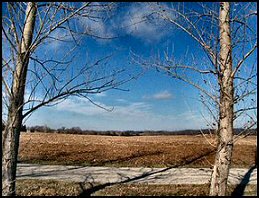Driving a 1950s route
Dennis has been wanting some more work pants, so today I drove up to the VF factory outlet store at Hanson, KY. Since I had plenty of time, I took the two-lane Highway 41 instead of the four-lane Pennyrile Parkway.
Before the parkway went in, Highway 41 was a major north-south route, and you can still see some of the gas stations, cafes, and motels that served the travelers. Most of them closed years ago, of course.
Going north from Hopkinsville, Highway 41 passes through Kelly, Crofton, Earlington, Morton's Gap, Madisonville, and finally Hanson. In addition, there are probably names that I don't know for some of little crossroads communities along the way. The railroad runs alongside the highway, and it goes right through the middle of most of these towns, too.
From Hopkinsville to Kelly, there are far too many delapidated trailer houses, but beyond Kelly, there are interesting things to see: pine-topped hills, long stretches of woods, farmer's fields, and roads that cut off and disappear into the countryside. Hopkins County is coal country, and it feels to me like it's a little higher in elevation than most of Christian County. On the map of Hopkins County, there are several large areas with no roads. I don't know if those are coal mining areas, or if they are just rough terrain where very few people live. (Or maybe both?)
I've always been curious about Morton's Gap because it has an interesting name, so I drove down its main street. I was disappointed not to see anything strikingly picturesque. I saw a tiny vacant building built in the 1920's that was inscribed, "City Hall". A big Catholic church sits on the hillside and a nice old brick house beside it is probably part of the church property. Nearby, I saw the nicely painted house in the photo below.

From Morton's Gap on to Hanson, it could be called "Greater Madisonville" because Morton's Gap flows into Earlington, and Earlington melts into the south side of Madisonville, and Hanson is a suburb on the north side of Madisonville.
On the south side of Madisonville, I saw some of the damage from the bad tornado that hit last fall. Dozens of trees are snapped off and some buildings are still strewn across the ground.

 Hanson has several attractive old buildings in the business district. (Part of the north side of the main street is shown in the photo.) The factory outlet store gets a lot of traffic, so they are trying to make the downtown area a secondary destination. There are three antique stores (the doorway of one is shown in in the photo at right) and a couple of restaurants in the one-block downtown area.
Hanson has several attractive old buildings in the business district. (Part of the north side of the main street is shown in the photo.) The factory outlet store gets a lot of traffic, so they are trying to make the downtown area a secondary destination. There are three antique stores (the doorway of one is shown in in the photo at right) and a couple of restaurants in the one-block downtown area.I arrived at the outlet store about 9:40 and it didn't open until 10:00, so I parked the car and waited. I had plenty of time to observe the building. It has no architectural pizzazz at all. It's a big, metal building, designed strictly for function.
As opening time approached, more customers began arriving. A van from the Elkton Baptist Church pulled up and half a dozen gray-haired ladies got out and waited by the door. They were ready to do some shopping. I had relished the journey; they were eager to arrive at the destination. (Or so it seemed to me, but maybe they thought they were just beginning their journey. Journey? Destination? Where does one stop and the other begin?)
The doors opened and we all went in. I bought Dennis three pairs of work pants and Isaac three pairs of jeans for school.






























